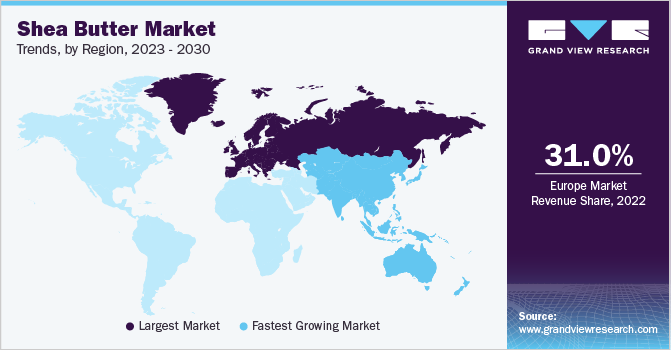Shea Butter Industry Overview
The global Shea Butter Market, with an estimated size of USD 2,412.4 million in 2024, is projected to expand at a CAGR of 7.9% from 2025 to 2030, primarily due to the rising consumer demand for natural and organic skincare products, where shea butter is recognized for its moisturizing, anti-inflammatory, and antioxidant benefits. The beauty and personal care sector is a key consumer, propelled by consumer preferences for eco-friendly and sustainable ingredients. Additionally, the market is gaining from increased production capabilities in regions like West Africa, where shea butter originates, and ongoing initiatives aimed at enhancing sustainability within the supply chain.
Market growth is significantly influenced by regulatory frameworks and international partnerships designed to boost product quality, safety, and sustainability. Within the U.S., shea butter products are strictly regulated by the FDA and USDA, ensuring consumer safety, preventing adulteration, and assuring truthful labeling. These regulations play a vital role in sustaining market confidence, especially in preventing the adulteration of shea butter, a primary concern in the U.S. market. The American Shea Butter Institute categorizes imported shea butter into different classes, highlighting the significance of using high-quality, pure shea butter for its effectiveness.
Detailed Segmentation:
- Product Insights
Refined shea butter sales are projected to grow at a CAGR of 7.6% from 2025 to 2030. Companies such as All Organic Treasures GmbH, a Germany-based provider, offer organic shea butter, with its refined version being a nearly odorless and tasteless white solid fat rich in oleic and stearic acid. The refined shea butter is certified as both organic and kosher, making it suitable for food applications, and has a shelf life of at least 18 months. The company collaborates with the Shea Savannah Fruit Company (SFC) to ensure compliance with food-grade certifications, including DE-ÖKO-007 and Kosher. This growing demand for refined shea butter, particularly in food products, reflects the increasing interest in high-quality, certified ingredients that meet both health and regulatory standards in markets like Europe, where ethical sourcing and natural ingredients are highly valued.
- Application Insights
Shea butter sales in the food industry are projected to grow at a CAGR of 8.5% from 2025 to 2030, driven by its increasing acceptance as a versatile, natural fat used in a variety of food products. Its benefits in enhancing texture, improving shelf life, and contributing to healthier fats have led to its incorporation in products like chocolates, bakery goods, ice creams, and frying oils. For instance, the approval of shea butter as a novel food ingredient in China in 2017 opened up new avenues for its use in food, aligning with rising consumer demand for diverse and healthier food ingredients. Furthermore, shea butter is gaining traction in the vegan food market due to its plant-based origins, which align with the growing trend for plant-based and ethical food alternatives.

- Regional Insights
The Asia Pacific shea butter market is expected to grow at a CAGR of 8.7% from 2025 to 2030. The growth of the market in the Asia Pacific region is being significantly influenced by efforts from various associations, notably the Global Shea Alliance (GSA). As of December 2022, the GSA, a key non-profit organization representing over 600 members globally, launched initiatives to expand shea butter's presence in the Asia Pacific cosmetics and health sectors. With strong roots in Europe and the U.S., the GSA is now focusing on connecting cosmetic brands in Japan, South Korea, and China with rural shea butter producers, primarily women cooperatives. This initiative is expected to empower local producers, promote the use of shea butter in cosmetics, and drive market growth in the region.
Gather more insights about the market drivers, restraints, and growth of the Shea Butter Market
Key Companies & Market Share Insights
The shea butter industry is fragmented, with the presence of many developed global players and many developing key market entrants. These players are engaging in major acquisition and promotional activities to increase their customer base and brand loyalty. Prominent companies include The Savannah Fruits Company (SFC), Bunge Loders Croklaan, and Olam International, which are key suppliers of raw shea butter, mainly sourced from Africa. These companies have a strong focus on sustainable sourcing and empowerment of women in West Africa, which aligns with the growing consumer demand for ethically sourced ingredients.
Key Shea Butter Companies:
The following are the leading companies in the shea butter market. These companies collectively hold the largest market share and dictate industry trends.
- BASF SE
- Olvea Group
- Sophim S.A.
- Cargill, Inc.
- Suru Chemicals
- Ghana Nuts Company Ltd.
- Croda International Plc
- Agrobotanicals, LLC
- Clariant AG
- AAK AB
Order a free sample PDF of the Market Intelligence Study, published by Grand View Research.
Recent Developments
- The Ghana Shea Landscape Emission Reductions Project (GLSERP), launched in early 2024 with an investment of USD 54.5 million, aims to enhance sustainability in Shea farming. This initiative focuses on preventing deforestation, supporting local communities, and boosting the Shea butter value chain.


No comments:
Post a Comment